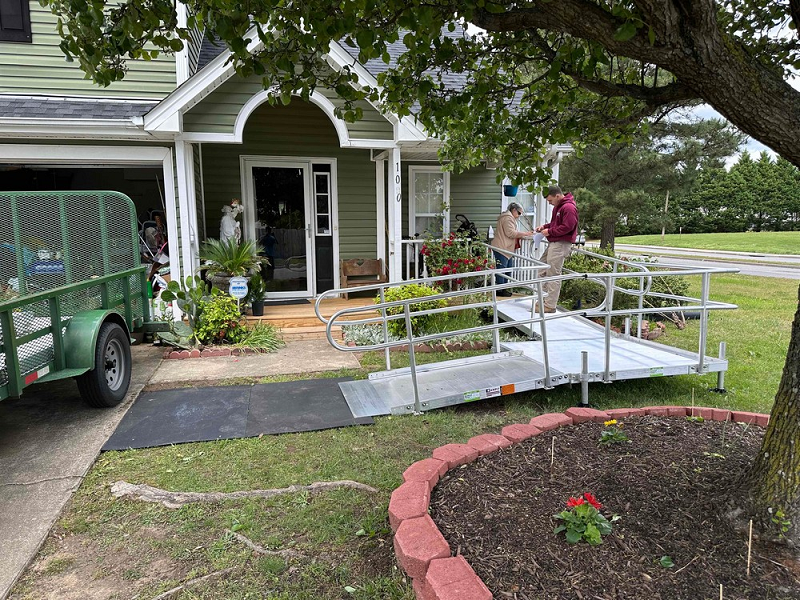
Types of Ramps: Finding the Perfect Fit for Your Home
Choosing the right ramp for your home is essential for enhancing accessibility, safety, and convenience. Whether you need a ramp for mobility aids, transporting heavy items, or future-proofing your home, understanding the different types of ramps available will help you make the best choice. Here’s a guide to the various types of ramps and how to find the perfect fit for your Suffolk County home.
1. Permanent Ramps
Permanent ramps are fixed structures designed for long-term use. They are typically constructed from durable materials like concrete, wood, or metal, and are often integrated into the design of the home.
Benefits:
- Durability: Built to last, permanent ramps can withstand heavy use and harsh weather conditions.
- Customization: Can be tailored to match your home’s architecture and landscape.
- Stability: Offers a solid, stable solution for regular use.
Ideal For:
- Homes with residents who have long-term mobility needs.
- Providing a seamless, integrated look with the home’s exterior.
- Enhancing property value with a permanent accessibility feature.
2. Portable Ramps
Portable ramps are lightweight and designed for temporary use. They can be moved and adjusted as needed, making them a versatile option for various accessibility needs.
Benefits:
- Flexibility: Can be easily transported and used in different locations.
- Affordability: Generally less expensive than permanent ramps.
- Convenience: Ideal for temporary situations or when traveling.
Ideal For:
- Short-term accessibility needs, such as visiting friends or family.
- Homes with limited space where a permanent ramp isn’t feasible.
- Renters who need a non-permanent solution.
3. Threshold Ramps
Threshold ramps are small ramps designed to bridge the gap over door thresholds, making it easier to move wheelchairs, scooters, and walkers through doorways.
Benefits:
- Easy Installation: Simple to install and remove as needed.
- Compact Design: Takes up minimal space and can be used indoors and outdoors.
- Cost-Effective: An affordable solution for overcoming small height differences.
Ideal For:
- Doorways with high thresholds that impede smooth access.
- Homes with multiple entry points that need minor adjustments.
- Providing seamless transitions between rooms or outdoor areas.
4. Folding Ramps
Folding ramps are designed to be easily folded and stored when not in use. They are typically made from lightweight materials like aluminum and are ideal for temporary or semi-permanent use.
Benefits:
- Portability: Can be folded and transported with ease.
- Space-Saving: Easy to store when not in use.
- Versatility: Suitable for various applications, both indoors and outdoors.
Ideal For:
- Temporary accessibility needs, such as events or short-term mobility issues.
- Homes with limited storage space.
- Individuals who travel frequently and need a portable ramp.
5. Modular Ramps
Modular ramps are made up of pre-fabricated sections that can be assembled and customized to fit specific needs. They offer a balance between the permanence of fixed ramps and the flexibility of portable ramps.
Benefits:
- Customizable: Can be tailored to fit the exact specifications of your home.
- Reconfigurable: Sections can be rearranged or added as needed.
- Durable: Built from sturdy materials designed for long-term use.
Ideal For:
- Homes with evolving accessibility needs.
- Situations where a permanent ramp isn’t possible, but long-term use is needed.
- Providing a robust, stable solution with the option for future adjustments.
6. Vehicle Ramps
Vehicle ramps are designed specifically for loading and unloading wheelchairs, scooters, and other mobility devices into and out of vehicles. They come in various lengths and styles to accommodate different types of vehicles.
Benefits:
- Ease of Use: Makes it simple to load and unload mobility devices.
- Portability: Lightweight and easy to transport.
- Compatibility: Available in different sizes to fit various vehicle types.
Ideal For:
- Individuals who frequently travel by car and need a reliable way to transport mobility aids.
- Ensuring accessibility when using multiple vehicles.
- Providing a portable solution for on-the-go needs.
Conclusion
Selecting the right type of ramp for your Suffolk County home depends on your specific needs, budget, and preferences. Whether you require a permanent structure for long-term accessibility, a portable solution for temporary use, or a specialized ramp for your vehicle, understanding the options available will help you make an informed decision. Enhance the safety, convenience, and accessibility of your home by choosing the perfect ramp to fit your lifestyle.

